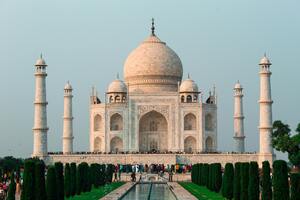PAQUETES TURÍSTICOS DE AGRA By Tour Por la India Company
Posted By tour por la India
Body
The Tour Por la India Company's AGRA TOUR PACKAGES
Overview of Tour Packages for Agra
Tour Por la India Company's painstakingly designed tour packages will help you explore the fascinating city of Agra. Agra, the location of the renowned Taj Mahal, provides tourists with an overview of India's magnificent architecture and rich cultural legacy. These tour packages offer an immersive and fascinating experience through this historic city, whether your interests include discovering historical sites, sampling local cuisine, or indulging in traditional crafts.
Day 1: Getting to know Agra
When you arrive in Agra, you are greeted with warmth by Tour Por la India Company, marking the start of your experience. After checking into your accommodation, unwind for a little before beginning your city sightseeing. You may take in the lively ambiance of Agra by visiting the local markets in the evening and shopping for mementos and sampling delectable street cuisine.
Day 2: Sunrise Tour of the Taj Mahal
Visit the renowned Taj Mahal at dawn to begin your day. This architectural marvel and UNESCO World Heritage site is not to be missed. Take in the breathtaking vistas, discover the monument's interesting history, and discover the symbolic of eternal love as you see the white marble structure illuminated by the gentle morning light. Take your time discovering this famous monument's gardens and fine detailing.
Day 3: Local Heritage and the Agra Fort
On the third day, discover Agra's rich history by going to Agra Fort, a UNESCO World Heritage site that was the Mughal rulers' primary residence. Explore its courtyards, mosques, and palaces while taking in expansive vistas of the Taj Mahal from various spots throughout the fort. Visit traditional workshops later to learn more about the local way of life and see how craftspeople make beautiful handicrafts like embroidered and marble inlay work.
Day 4: Trip to Fatehpur Sikri
Take a trip to Fatehpur Sikri, a UNESCO World Heritage site that is an abandoned Mughal city renowned for its historically significant and well-preserved architecture. Discover the magnificent buildings, such as Buland Darwaza, Jama Masjid, and Panch Mahal, to have a better understanding of the Mughal Empire's heyday. Go back to Agra and relax for the evening, maybe having a neighborhood restaurant's traditional dinner.
Day 5: After leaving Agra
Enjoy any last sights and activities in Agra, according to your interests, on your last day. The Tour Por la India Company makes sure your departure goes smoothly by organizing transportation to the train or airport so you may continue your travels. As you wave adieu to this ancient city, savor the moments that will never be forgotten and the cultural knowledge you acquired.
In conclusion, the Agra tour packages offered by Tour Por la India Company provide a thorough examination of the city's cultural legacy, including the breathtaking Taj Mahal, the opulence of Agra Fort, and the exquisite local craftsmen' work. These itineraries cater to every interest, assuring an interesting and gratifying travel experience, whether you're a history buff, a photography enthusiast, or a leisure traveler looking to immerse oneself in India's rich tapestry of culture.
FAQs Following The Wrap-Up
When would be the best to travel to Agra?
When the weather is nice enough for touring, October through March is the ideal time of year to visit Agra.
Do the travel packages to Agra include meals?
Usually, meals are included in the package. There could be options to eat at nearby restaurants.
Is it possible to add more Agra sites to the itinerary?
Yes, the Tour Por la India Company provides adjustable choices so that each traveler's schedule can be customized to suit their tastes.
Does every travel package to Agra include a visit to the Taj Mahal?
Indeed, one of the highlights of any Agra travel package that travel Por la India Company offers is seeing the Taj Mahal.
What should I bring for a tour of Agra?
It is advised to bring light clothing, a hat, sunscreen, and comfortable walking shoes for seeing marketplaces and historical buildings.
ALSO READ-
Supervivientes: Examining the Craft of Surviving in Adverse Circumstances
Overview
What does the term "Supervivientes" mean?
Why Is Survival Such a Big Deal to Us?
The Mentality of Survival
Knowing Your Survival Instincts
The role of adaptation in extreme environments, or the fight-or-flight response
Competencies Required for Survival
Essential Survival Skills That Everyone Should Understand
Techniques for Constructing Shelters
Techniques for Lighting Fires
Difficulties Under Harsh Conditions
Extreme Weather Conditions
Handling Severe Heat
How to Live in Subzero Temperatures
Orientation and Navigation: The Value of Navigational Skills
Making Use of Natural Signposts
How to Read Maps and Use Compass Basics: Locating Food and Water Sources
Methods for Obtaining Reliable Water Filtering and Purification Systems
Plants and Insects You Can Eat
First Aid in Circumstances of Survival
Common Injuries and Their Handling Remedies Cuts and Injuries
Handling Heatstroke and Hypothermia
Surviving in Psychological Aspects
Sustaining Mental Hardiness
Handling Being Alone
The Value of Positive Thoughts Essential Tools and Equipment for a Survival Kit
Multi-User and Blade
Supplies for an Emergency Shelter
Narratives of Survivability and Case Studies
Examples of Actual Shipwreck Survivors in Survival
Rescues of Lost Hikers
Getting Ready for Survival
Where to Acquire Survival Skills
Schools of Outdoor Survival
Online Courses and Resources
Survival's Ethical Considerations
Honoring the Environment and Wildlife
The Leave No Trace philosophy
Ethical Guidelines for Hunting
FAQs about Supervivientes in Conclusion
Which material makes an ideal shelter in the bitter cold?
How much time can a person live without water?
When lost, is it best to stay put or go in search of assistance?
What ought to be a basic survival kit's contents?
What are the practical benefits of survival skills?
Overview of Tour Packages for Agra
Tour Por la India Company's painstakingly designed tour packages will help you explore the fascinating city of Agra. Agra, the location of the renowned Taj Mahal, provides tourists with an overview of India's magnificent architecture and rich cultural legacy. These tour packages offer an immersive and fascinating experience through this historic city, whether your interests include discovering historical sites, sampling local cuisine, or indulging in traditional crafts.
Day 1: Getting to know Agra
When you arrive in Agra, you are greeted with warmth by Tour Por la India Company, marking the start of your experience. After checking into your accommodation, unwind for a little before beginning your city sightseeing. You may take in the lively ambiance of Agra by visiting the local markets in the evening and shopping for mementos and sampling delectable street cuisine.
Day 2: Sunrise Tour of the Taj Mahal
Visit the renowned Taj Mahal at dawn to begin your day. This architectural marvel and UNESCO World Heritage site is not to be missed. Take in the breathtaking vistas, discover the monument's interesting history, and discover the symbolic of eternal love as you see the white marble structure illuminated by the gentle morning light. Take your time discovering this famous monument's gardens and fine detailing.
Day 3: Local Heritage and the Agra Fort
On the third day, discover Agra's rich history by going to Agra Fort, a UNESCO World Heritage site that was the Mughal rulers' primary residence. Explore its courtyards, mosques, and palaces while taking in expansive vistas of the Taj Mahal from various spots throughout the fort. Visit traditional workshops later to learn more about the local way of life and see how craftspeople make beautiful handicrafts like embroidered and marble inlay work.
Day 4: Trip to Fatehpur Sikri
Take a trip to Fatehpur Sikri, a UNESCO World Heritage site that is an abandoned Mughal city renowned for its historically significant and well-preserved architecture. Discover the magnificent buildings, such as Buland Darwaza, Jama Masjid, and Panch Mahal, to have a better understanding of the Mughal Empire's heyday. Go back to Agra and relax for the evening, maybe having a neighborhood restaurant's traditional dinner.
Day 5: After leaving Agra
Enjoy any last sights and activities in Agra, according to your interests, on your last day. The Tour Por la India Company makes sure your departure goes smoothly by organizing transportation to the train or airport so you may continue your travels. As you wave adieu to this ancient city, savor the moments that will never be forgotten and the cultural knowledge you acquired.
In conclusion, the Agra tour packages offered by Tour Por la India Company provide a thorough examination of the city's cultural legacy, including the breathtaking Taj Mahal, the opulence of Agra Fort, and the exquisite local craftsmen' work. These itineraries cater to every interest, assuring an interesting and gratifying travel experience, whether you're a history buff, a photography enthusiast, or a leisure traveler looking to immerse oneself in India's rich tapestry of culture.
FAQs Following The Wrap-Up
When would be the best to travel to Agra?
When the weather is nice enough for touring, October through March is the ideal time of year to visit Agra.
Do the travel packages to Agra include meals?
Usually, meals are included in the package. There could be options to eat at nearby restaurants.
Is it possible to add more Agra sites to the itinerary?
Yes, the Tour Por la India Company provides adjustable choices so that each traveler's schedule can be customized to suit their tastes.
Does every travel package to Agra include a visit to the Taj Mahal?
Indeed, one of the highlights of any Agra travel package that travel Por la India Company offers is seeing the Taj Mahal.
What should I bring for a tour of Agra?
It is advised to bring light clothing, a hat, sunscreen, and comfortable walking shoes for seeing marketplaces and historical buildings.
ALSO READ-
Supervivientes: Examining the Craft of Surviving in Adverse Circumstances
Overview
What does the term "Supervivientes" mean?
Why Is Survival Such a Big Deal to Us?
The Mentality of Survival
Knowing Your Survival Instincts
The role of adaptation in extreme environments, or the fight-or-flight response
Competencies Required for Survival
Essential Survival Skills That Everyone Should Understand
Techniques for Constructing Shelters
Techniques for Lighting Fires
Difficulties Under Harsh Conditions
Extreme Weather Conditions
Handling Severe Heat
How to Live in Subzero Temperatures
Orientation and Navigation: The Value of Navigational Skills
Making Use of Natural Signposts
How to Read Maps and Use Compass Basics: Locating Food and Water Sources
Methods for Obtaining Reliable Water Filtering and Purification Systems
Plants and Insects You Can Eat
First Aid in Circumstances of Survival
Common Injuries and Their Handling Remedies Cuts and Injuries
Handling Heatstroke and Hypothermia
Surviving in Psychological Aspects
Sustaining Mental Hardiness
Handling Being Alone
The Value of Positive Thoughts Essential Tools and Equipment for a Survival Kit
Multi-User and Blade
Supplies for an Emergency Shelter
Narratives of Survivability and Case Studies
Examples of Actual Shipwreck Survivors in Survival
Rescues of Lost Hikers
Getting Ready for Survival
Where to Acquire Survival Skills
Schools of Outdoor Survival
Online Courses and Resources
Survival's Ethical Considerations
Honoring the Environment and Wildlife
The Leave No Trace philosophy
Ethical Guidelines for Hunting
FAQs about Supervivientes in Conclusion
Which material makes an ideal shelter in the bitter cold?
How much time can a person live without water?
When lost, is it best to stay put or go in search of assistance?
What ought to be a basic survival kit's contents?
What are the practical benefits of survival skills?














Comments